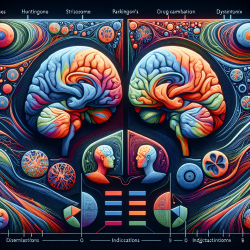The basal ganglia, a group of subcortical nuclei in the brain, play a crucial role in motor control and learning. Within the basal ganglia lies the striatum, which is divided into two main compartments: the striosomes and the matrix. Recent research has highlighted the significance of imbalances between these compartments in contributing to various neurological disorders such as Huntington's disease, Parkinson's disease, dystonia, and drug addiction.
The Striosome-Matrix Architecture
The striatum is composed mainly of medium spiny neurons (MSNs), which can be classified based on their location within the striosomes or matrix. The matrix primarily contains MSNs involved in sensorimotor and associative circuits, while striosomes are enriched with MSNs that interact with limbic regions. This compartmentalization is critical for understanding how different pathways within the basal ganglia contribute to behavior and disease.
Imbalances and Neurological Disorders
Research indicates that imbalances between striosome and matrix functions are associated with several disorders:
- Huntington's Disease: Early-stage Huntington's disease often shows preferential loss of neurons in the striosomes. This imbalance may correlate with mood disturbances observed in patients.
- Parkinson's Disease: L-DOPA-induced dyskinesias (LIDs), a common side effect of Parkinson's treatment, have been linked to hyperactivity in striosomes relative to the matrix.
- Dystonia: Certain forms of dystonia exhibit selective degeneration of striosomal neurons, suggesting a compartment-specific vulnerability.
- Drug Addiction: Increased activity in striosomes compared to the matrix has been observed following exposure to drugs of abuse, potentially contributing to addictive behaviors.
Implications for Therapy and Research
The findings from studies on striosome-matrix imbalances provide valuable insights into potential therapeutic targets. For instance, modulating the activity within these compartments could help alleviate symptoms associated with LIDs or reduce vulnerability to addiction. Furthermore, understanding these imbalances encourages further research into developing specific interventions that target these pathways.
For practitioners working with patients affected by these disorders, staying informed about such research can enhance their ability to provide effective treatments. Encouraging further exploration into this field could lead to breakthroughs in understanding and managing basal ganglia-related conditions.
To read the original research paper, please follow this link: Basal Ganglia Disorders Associated with Imbalances in the Striatal Striosome and Matrix Compartments.










